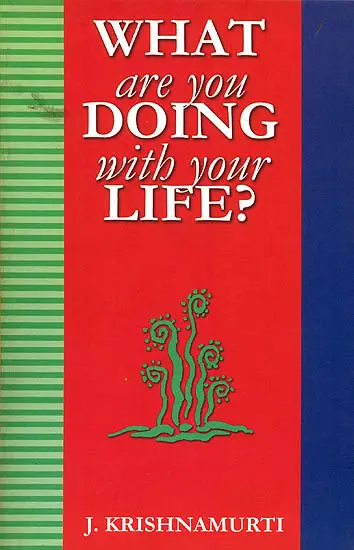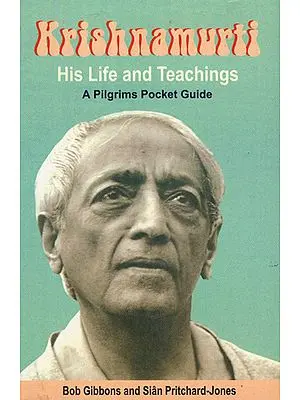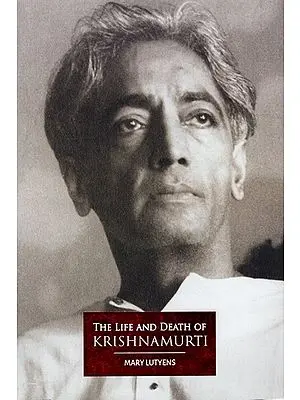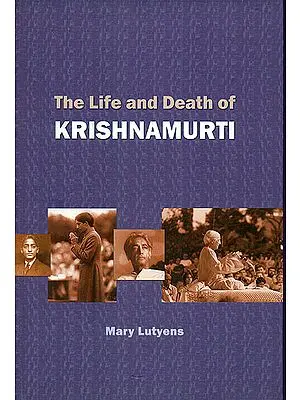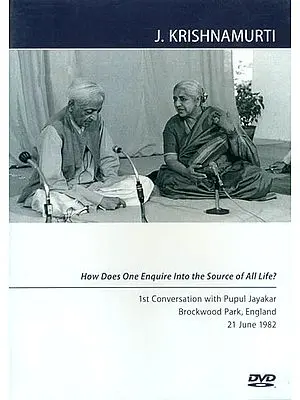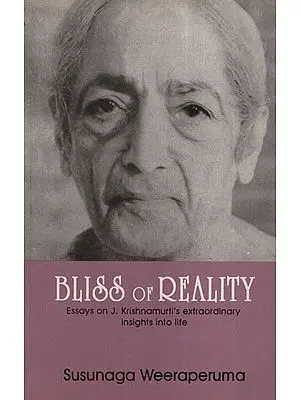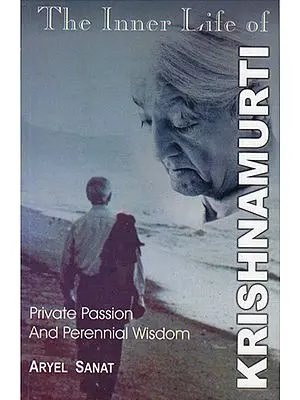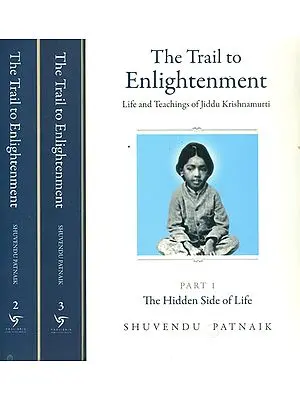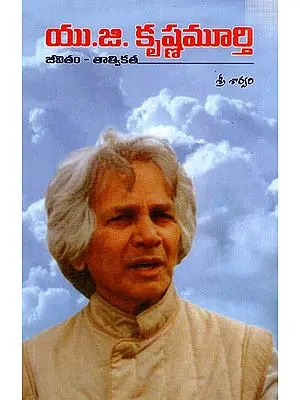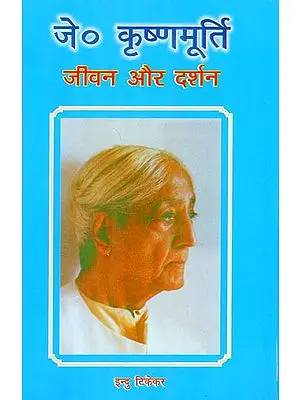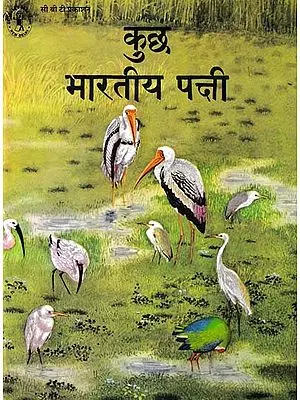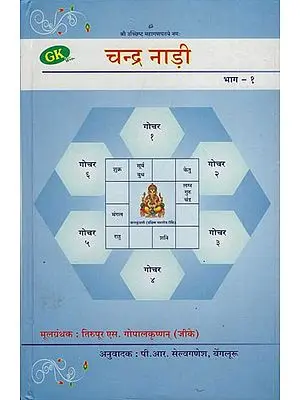What Are You Doing With Your Life?
| Express Shipping: Guaranteed Dispatch in 24 hours |
|
| Item Code: | NAD670 |
| Author: | J. Krishnamurti |
| Publisher: | Krishnamuriti Foundation India |
| Edition: | 2023 |
| ISBN: | 8187326352 |
| Pages: | 276 (26 B/W Illustrations) |
| Cover: | Paperback |
| Other Details | 8.5 inch X 5.5 inch |
| Weight | 310 gm |
What are you Doing with your Life? Brings together excerpts from Krishnamurti's books, and is the first anthology of its kind that offers the young a systematic approach to Ius vision of education and life
J. Krishnamurti's investigation of these questions constitutes a most original and authentic contribution to the educational thought of the twentieth century. In talking to students and holding discussions with them in different parts of the world, what he sought to impart was not a 'philosophy' of life but rather the art of observing directly one's life. And he talked to them as a friend, and not as a guru or an expert on these Issues.
Jiddu Krishnamurti (1895-1986) was born of Indian parents, educated in England, and gave talks around the world. He claimed allegiance to no caste, nationality, or religion and was bound by no tradition.
His teachings of more than 20,000,000 words are published in more than 75 books, 700 audiocassettes, and 1200 video- cassettes. Thus far, over 4,000,000 copies of books have been sold in twenty-two languages. Together with the Dalai Lama and Mother Teresa, Krishnamurti was declared by Time magazine to be one of the five saints of the 20th century.
He traveled the world for sixty-five years speaking spontaneously to large audiences until the end of his life at ageninety. The rejection of all spiritual and psychological authority, including his own, is a fundamental theme. He said man has to free himself of fear, conditioning, authority, and dogma through self-knowledge. He suggested this will bring about order and real psychological change. The conflict- ridden violent world cannot be transformed into a life of goodness, love, and compassion by ahy political, social, or economic strategies. It can be transformed only through mutation in individuals brought about through their own observation without any guru or organized religion.
Krishnamurti's stature as an original philosopher attracted traditional and non-traditional thinkers and philosophers alike. Heads of state, eminent physicists such as David Bohm, prominent leaders of the United Nations, psychiatrists, psychologists, religious leaders, and university professors engaged in dialogue with Krishnamurti. Students, teachers, and millions of people from all walks of life came to hear him speak and read his books. He bridged science and religion without the use of jargon, so scientists and lay people alike could understand his discussions of time, thought, insight, and death.
He established foundations in the United States, India, England, Canada, Spain, with the defined role of protecting the teachings from being distorted and for disseminating his work, without the authority to interpret or deify the teachings or the person.
In establishing the many schools he founded in India, England, and the United States, Krishnamurti envisioned that education should emphasize the understanding of the mind and heart, not mere academic and intellectual skills; and skills in the art of living, not only the technology to make a living.
Krishnamurti said, "Surely a school is a place where one learns about the totality, the wholeness of life. Academic excellence is absolutely necessary, but a school includes much more than that. It is a place where both the teacher and the taught explore not only the outer world, the world of knowledge, but also their own thinking, their behavior."
He said of his work, "There is no belief demanded or asked, there are no followers, there are no cults, there is no persuasion of any kind, in any direction, and therefore only then we can meet on the same platform, on the same ground, at the same level. Then we can together observe the extraordinary phenomena of human existence."
The way you and I relate to our own brains, to each other, to our own possessions, to money, to work, to sex-these immediate relationships create society. Our relationship to ourselves and one another multiplied by six billion creates the world. The collection of each of our prejudices, all our separate lonelinesses put together, each greedy ambition, each physical or emotional hunger, every anger and sadness in every one of us-we are the world.
The world is not different from us-the world is us. So it is simple: if we change, each one of us, we change the world. If even one of us changes, it has a ripple effect. Goodness is contagious.
In school, we are educated to listen to our parents and teachers. Technologically, this makes sense. But thousands of generations have still not learned psychologically how to stop suffering and stop inflicting suffering on others. Psy- chological evolution has not accompanied biological or sci- entific evolution. In school, we can all learn how to make a living: the art of living, however, we- ust each learn on our own.
Life hurts us all, from loneliness, confusion, the feelings of failure, despair. Life hurts from being poor, emotionally ill, from violence in the streets or at home. We are taught many things, but rarely how to deal with the shock of life's hurts. For one thing, we are not taught that it is not life, but our own reactions to what happens to us that is the cause of pain. It is our fear, rooted in self-protection that causes the pain. To protect the body is natural: but is it natural to protect what we call our 'self?' What is this self that is the root of the trouble, the psychological pain we feel when we try to protect it?
If you merely escape mental pain and confusion with drugs, entertainment, sex, busyness, the painful problem is still there, compounded with exhaustion and addiction. Attention to the ways of the self, understanding that fear, de- sire, and anger are natural but that you don't have to act them out or have everything you want-this insight dissolves mental anguish without adding to it.
We need to learn to understand the self to understand that it is the source of our problems. Not to be self-absorbed, but to pay attention to the thoughts, feelings, activities of the self, its biological and personal, gender and cultural conditioning: this is meditation.
These talks and writings are by a man who lived in the same way as society's great outsiders: the rebel; the wandering poet; the religious philosopher; iconoclastic sage; the breakthrough scientists and psychologists; the great traveling teachers of all millennia. For sixty-five years, Krishnamurti spoke of psychological freedom to whoever would listen to his message. He founded schools for children, teens, young adults, where young people can study all the usual subjects-and themselves as well. In the schools, as in all the talks and writings, he points out that it is not our wars, inner and outer, that will set us free, but the truth about ourselves.
There is no path, no authority, no guru to follow: you have the capacity in yourself to find out what you are, what you are doing with your life, your relationships, and with your work. You must experiment with what is said in this book.
Someone else's truth sounds like only opinion until you try it out for yourself. You must look through the microscope yourself, or you will be left with the dust of words, not the actual perception of life.
We are usually taught what to think, but not how to think. We learn how to escape loneliness and mental suffering, not how to put an end to it.
All of the selections in this volume are taken from Krishnamurti's books, his reported and recorded dialogues and public talks. Try the experiment of reading this book, and further sources listed in the back, and see for you what happens.
| Foreword | VII | |
| Introduction | XI | |
| Section One : Your Self And Your Life | ||
| 1 | What Are You? | 3 |
| 2 | What Do You Want? | 14 |
| 3 | Thought, the Thinker, and the Prison of the Self | 24 |
| 4 | Insight, Intelligence, and Revolution in Your Life | 34 |
| 5 | Escape; Entertainment; Pleasure | 44 |
| 6 | Why Should We Change? | 54 |
| 7 | What Is the Purpose of.Life? | 58 |
| Sectio Two: Self-Knowledge The Key to Freedom | ||
| 1 | Fear | 67 |
| 2 | Anger and Violence | 74 |
| 3 | Boredom and Interest | 87 |
| 4 | Self-Pity; Sorrow; Suffering | 93 |
| 5 | Jealousy; Possessiveness; Envy | 101 |
| 6 | Desire and Longing | 111 |
| 7 | Self-Esteem: Success and Failure | 120 |
| 8 | Loneliness; Depression; Confusion | 129 |
| 9 | Self-Ending-Not Self-Improvement Ends Suffering | 143 |
| Section Three: Education Work and Money | ||
| 1 | What Is Education? | 153 |
| 2 | Comparison and Competition, or Cooperation? | 161 |
| 3 | Work: How Do You Decide? | 168 |
| 4 | What Is the Basis for Right Action? | 179 |
| Section Four: Relationships | ||
| 1 | What Is Relationship? | 189 |
| 2 | Love; Desire; Sex; Dependency | 198 |
| 3 | Family and Society: Relationship or Exclusion? | 203 |
| 4 | Nature and Earth | 208 |
| 5 | Marriage: Love and Sex | 212 |
| 6 | Passion | 228 |
| 7 | Truth; God; Death | 232 |
| 8 | Meditation Is Attention | 242 |
| Sources | 252 | |
| Index | 258 | |
| Recommended Reading | 265 |
-
Q. What locations do you deliver to ?A. Exotic India delivers orders to all countries having diplomatic relations with India.
-
Q. Do you offer free shipping ?A. Exotic India offers free shipping on all orders of value of $30 USD or more.
-
Q. Can I return the book?A. All returns must be postmarked within seven (7) days of the delivery date. All returned items must be in new and unused condition, with all original tags and labels attached. To know more please view our return policy
-
Q. Do you offer express shipping ?A. Yes, we do have a chargeable express shipping facility available. You can select express shipping while checking out on the website.
-
Q. I accidentally entered wrong delivery address, can I change the address ?A. Delivery addresses can only be changed only incase the order has not been shipped yet. Incase of an address change, you can reach us at help@exoticindia.com
-
Q. How do I track my order ?A. You can track your orders simply entering your order number through here or through your past orders if you are signed in on the website.
-
Q. How can I cancel an order ?A. An order can only be cancelled if it has not been shipped. To cancel an order, kindly reach out to us through help@exoticindia.com.
